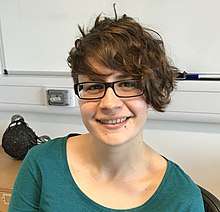Sam Giles
| Sam Giles | |
|---|---|
 | |
| Alma mater |
University of Bristol University of Oxford |
| Scientific career | |
| Institutions | University of Oxford |
Sam Giles is a palaeobiologist at the University of Birmingham. Her research combines modern imaging with fossils to understand the evolution of life. She was a 2017 L'Oréal-UNESCO Rising Star.
Early life and education
Giles studied geology at the University of Bristol, graduating in 2011.[1] Giles completed her PhD at the University of Oxford in 2015, where she was a member of St Hugh's College.[2] She worked with Matt Friedman on early ray-finned fishes.[3] In 2015 Giles was appointed a junior research fellow at Christ Church, Oxford. Giles was awarded a L'Oréal-UNESCO fellowship in 2016, which would allow her to study the anatomy of vertebrate's brains.[4][5] In 2017 Giles was awarded a Royal Society Dorothy Hodgkin Fellowship to study the evolution of the actinopterygii.[6][7] In 2018 she joined the School of Geography, Earth & Environmental Sciences at the University of Birmingham as a member of academic staff.
Research
Giles uses x-ray tomography to study the bone structure of Actinopterygii.[2] Whilst the long held assumption was that sharks were primitive forms of fish, Giles found that our latest common ancestors are not like sharks, but common bony and cartilaginous.[8][9][10][11] Giles identified a new genus of Actinopterygii, which provided a new model of cranial anatomy.[12] She used synchrotron-CT scans to examine the endoskeletal anatomy of Cheirolepis.[13]
The ray-finned fishes comprise half of extinct vertebrate species.[14] She compares the brains of ancient and modern fish, which helps to understand the evolution of the brain.[2] Giles identified that ray-finned fish originated during the Devonian-Carboniferous boundary.[2][15] By comparing scanilepiform fossils and Bichir, Giles found that ray-finned fishes were 40 million years younger than previously expected.[16][17][18] She also studied Meemannia, finding lateral carnial and spiracular canals.[19] She also works on Placodermi and Gnathostomata.[20]
She has written for the HuffPost and given several popular science lectures.[21][22]
References
- ↑ "Dr Sam Giles | Christ Church, Oxford University". www.chch.ox.ac.uk. Retrieved 2018-09-29.
- 1 2 3 4 "Dr Sam Giles wins L'Oréal-UNESCO for Women in Science Fellowship | St Hugh's College, Oxford". St Hugh's College, Oxford. 2016-11-02. Retrieved 2018-09-29.
- ↑ Giles, Sam; Friedman, Matt (2014-07). "Virtual reconstruction of endocast anatomy in early ray-finned fishes (Osteichthyes, Actinopterygii)". Journal of Paleontology. 88 (4): 636–651. doi:10.1666/13-094. ISSN 0022-3360. Check date values in:
|date=(help) - ↑ "Dr Sam Giles Awarded 2017 L'Oreal-UNESCO International Rising Talent Fellowship | Christ Church, Oxford University". www.chch.ox.ac.uk. Retrieved 2018-09-29.
- ↑ "Two Oxford scientists selected for 'Women in Science' Fellowships | University of Oxford". www.ox.ac.uk. Retrieved 2018-09-29.
- ↑ "Sam Giles | Royal Society". royalsociety.org. Retrieved 2018-09-29.
- ↑ "Royal Society announces Dorothy Hodgkin Fellows for 2017 | Royal Society". royalsociety.org. Retrieved 2018-09-29.
- ↑ "Ancient 420-million-year-old fossil hints of bony fish and cartilaginous fish common ancestor". ZME Science. 2015-01-13. Retrieved 2018-09-29.
- ↑ "Two-faced fish clue that our ancestors 'weren't shark-like'". ScienceDaily. Retrieved 2018-09-29.
- ↑ "Fossil fish reveals sharks lost bony armour early in their evolution | Imperial News | Imperial College London". Imperial News. Retrieved 2018-09-29.
- ↑ Giles, Sam; Friedman, Matt; Brazeau, Martin D. (2015-01-12). "Osteichthyan-like cranial conditions in an Early Devonian stem gnathostome". Nature. 520 (7545): 82–85. doi:10.1038/nature14065. ISSN 0028-0836. PMC 5536226. PMID 25581798.
- ↑ Giles, Sam; Darras, Laurent; Clément, Gaël; Blieck, Alain; Friedman, Matt (2015-10-07). "An exceptionally preserved Late Devonian actinopterygian provides a new model for primitive cranial anatomy in ray-finned fishes". Proc. R. Soc. B. 282 (1816): 20151485. doi:10.1098/rspb.2015.1485. ISSN 0962-8452. PMC 4614771. PMID 26423841.
- ↑ Giles, Sam; Coates, Michael I.; Garwood, Russell J.; Brazeau, Martin D.; Atwood, Robert; Johanson, Zerina; Friedman, Matt (2015-07-14). "Endoskeletal structure inCheirolepis(Osteichthyes, Actinopterygii), An early ray-finned fish". Palaeontology. 58 (5): 849–870. doi:10.1111/pala.12182. ISSN 0031-0239. PMC 4950109. PMID 27478252.
- ↑ Giles, Sam; Xu, Guang-Hui; Near, Thomas J.; Friedman, Matt (2017-08-30). "Early members of 'living fossil' lineage imply later origin of modern ray-finned fishes". Nature. 549 (7671): 265–268. doi:10.1038/nature23654. ISSN 0028-0836. PMID 28854173.
- ↑ Clement, Alice M; King, Benedict; Giles, Sam; Choo, Brian; Ahlberg, Per E; Young, Gavin C; Long, John A (2018-05-29). "Neurocranial anatomy of an enigmatic Early Devonian fish sheds light on early osteichthyan evolution". eLife. 7. doi:10.7554/eLife.34349. ISSN 2050-084X. PMC 5973833. PMID 29807569.
- ↑ "Ancient fish skulls shake up the vertebrate evolutionary tree". Ars Technica. Retrieved 2018-09-29.
- ↑ "Ancient fossil may rewrite fish family tree". Science | AAAS. 2015-01-12. Retrieved 2018-09-29.
- ↑ "Shaking up the fish family tree: 'Living fossil' not as old as we thought". University of Michigan News. 2017-08-30. Retrieved 2018-09-29.
- ↑ Lu, Jing; Giles, Sam; Friedman, Matt; den Blaauwen, Jan L.; Zhu, Min (2016-06). "The Oldest Actinopterygian Highlights the Cryptic Early History of the Hyperdiverse Ray-Finned Fishes". Current Biology. 26 (12): 1602–1608. doi:10.1016/j.cub.2016.04.045. ISSN 0960-9822. PMID 27212403. Check date values in:
|date=(help) - ↑ "TW:eed Project - Associate/Volunteers". tetrapods.org. Retrieved 2018-09-29.
- ↑ "Dr Sam Giles". HuffPost UK. Retrieved 2018-09-29.
- ↑ "Fossil Fish". www.birmingham.ac.uk. Retrieved 2018-09-29.